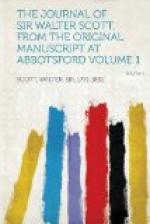Went down in the morning to Montagu House, where I found the Duke going out to suffer a recovery.[194] I had some fancy to see the ceremony, but more to get my breakfast, which I took at a coffee-house at Charing Cross.
I sat to Northcote, who is to introduce himself in the same piece in the act of painting me, like some pictures of the Venetian school. The artist is an old man, low in stature, and bent with years—fourscore at least. But the eye is quick and the countenance noble. A pleasant companion, familiar with recollections of Sir Joshua, Samuel Johnson, Burke, Goldsmith, etc. His account of the last confirms all that we have heard of his oddities.
Dined with Mr. Arbuthnot, where met Duke of Rutland, Lord and Lady Londonderry, etc. etc. Went to hear Mrs. Arkwright at Lady Charlotte Greville’s. Lockhart came home to-day.
May 10.—Another long sitting to the old Wizard Northcote. He really resembles an animated mummy.[195] He has altered my ideas of Sir Joshua Reynolds, whom, from the expressions used by Goldsmith, Johnson, and others, I used to think an amiable and benevolent character. But though not void of generosity, he was cold, unfeeling, and indifferent to his family: so much so that his sister, Miss Reynolds, after expressing her wonder at the general acceptance which Sir Joshua met with in society, concluded with, “For me, I only see in him a dark gloomy tyrant.” I own this view of his character hurt me, by depriving me of the pleasing vision of the highest talents united with the kindest temper. But Northcote says his disagreeable points were rather negative than positive—more a want of feeling than any desire to hurt or tyrannise. They arose from his exclusive attachment to art.




